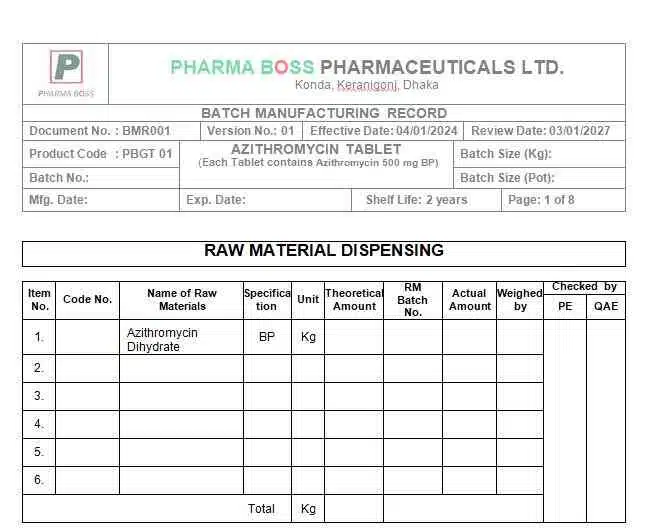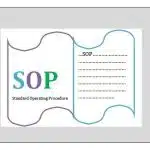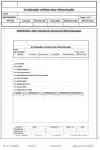In pharmaceutical manufacturing, reviewing BMR (Batch Manufacturing Records), BCR (Batch Coating Records) , and BPR (Batch Packaging Records) is essential to ensure compliance with Good Manufacturing Practices (GMP), ensure product quality, and maintain regulatory standards.
Here is a checklist for reviewing these documents:
1. General Documentation Checks
Correct Batch Number: Ensure the batch number is accurate and consistent across all documents.
Document Version: Verify the current version of the BMR/BCR/BPR is used as per the company’s SOP.
Completion of Records: Check that all fields are filled out correctly; including dates, times, signatures, and initials.
Legibility and Clarity: Ensure all entries are legible, clear, and without unauthorized alterations. Corrections, if any, should be properly justified with a reason and signed off.
Document Control: Confirm the records are maintained in a controlled manner and any attachments (e.g., supporting documents, deviations, etc.) are properly attached.

2. Checklist for Reviewing BMR (Batch Manufacturing Record)
i) Pre-Manufacturing Review
Material Dispensing:
Check that raw materials and excipients are dispensed as per the Master Formula.
Verify the quantity, batch number, and expiry date of each material.
Ensure that dispensing was carried out in line with approved SOPs.
Equipment Checks:
Confirm the equipment used is appropriately qualified and maintained.
Verify equipment cleaning logs, status labeling, and setup details.
Ensure the equipment’s ID number, calibration status, and cleaning status are documented.
ii) Manufacturing Process
Critical Steps:
Verify that critical process parameters (e.g., temperature, time, mixing speed) are followed.
Review in-process controls (e.g., pH, viscosity, etc.) to ensure they are within the specified range.
Confirm that process steps are completed in the correct sequence and signed off by operators and supervisors.
Deviations and Non-Conformance:
Review any deviations or non-conformance reported during manufacturing.
Ensure that corrective actions and justifications are documented and approved by Quality Assurance (QA).
iii) Yield and Reconciliation
Material Reconciliation:
Ensure that reconciliation of materials (starting material, in-process material, and final product) is correct and within acceptable limits.
Investigate discrepancies (if any) and ensure they are documented.
Product Yield:
Confirm that the actual product yield is within acceptable limits as defined in the batch record.
Verify that any significant deviations from theoretical yield are investigated.
3. Checklist for Reviewing BCR (Batch Coating Record)
i) Coating Process Review
Equipment Used:
Confirm that coating equipment (e.g., pan coater) is properly cleaned, calibrated, and maintained.
Verify that the equipment’s ID number, cleaning status, and calibration status are recorded.
Process Parameters:
Ensure coating parameters (e.g., spray rate, inlet/outlet temperature, pan speed) are within specified ranges.
Review humidity and environmental conditions during the coating process, if applicable.
In-Process Controls:
Verify that in-process quality checks, such as weight gain, thickness, and appearance, are within specification.
Ensure tablets or other dosage forms are evenly coated and conform to quality standards.
ii) Coating Solution Preparation
Material Checks:
Confirm that the coating solution is prepared as per the approved formulation.
Verify the batch number, quantity, and expiry date of the coating materials used.
Check that mixing times, speeds, and environmental conditions are as per protocol.
4. Checklist for Reviewing BPR (Batch Packaging Record)
i) Pre-Packaging Checks
Packaging Material Reconciliation:
Ensure that packaging materials (blisters, bottles, labels, cartons) are verified for correct batch numbers, quantities, and expiry dates.
Check for any discrepancies between issued and used quantities.
Line Clearance:
Confirm that proper line clearance has been performed before starting the packaging process.
Review documentation to ensure that no remnants from previous batches are present on the line.
ii) Packaging Process
Machine Parameters:
Verify that the packaging machine settings are documented and meet the specified criteria (e.g., sealing temperature, fill weight, labeling accuracy).
Ensure machine start and stop times are logged correctly.
In-Process Controls:
Check that in-process controls (e.g., weight checks, seal integrity, label checks) are performed at defined intervals and meet specifications.
Verify that any out-of-specification results have been addressed and documented.
iii) Final Packaging Inspection
Appearance and Labeling:
Ensure that final packaging conforms to approved specifications, including label placement, lot numbers, and expiry dates.
Review samples of the finished product to ensure no visible defects in packaging or labeling.
Reconciliation:
Verify the reconciliation of finished products, packaging materials, and rejected items.
Check that the number of units packaged matches the expected yield based on manufacturing outputs.
5. Quality Control (QC) Checks
Test Results: Review QC test results for the batch, ensuring all required tests (e.g., assay, dissolution, microbial, etc.) have passed.
Sample Integrity: Verify that retention samples have been taken and stored correctly for future reference.
Release Authorization: Ensure that the final product has been reviewed and approved by Quality Assurance before release.
6. Deviations, Change Control, and CAPA (Corrective and Preventive Actions)
Deviations:
Confirm any deviations are documented, investigated, and closed with appropriate corrective actions.
Change Control:
Verify if any changes occurred during manufacturing/packaging, and check if they were managed under the change control process.
CAPA: Review if any CAPAs were raised and ensure they were implemented and closed properly.
7. Approval
Signatures and Dates:
Ensure that all sections of the BMR, BCR, and BPR are signed and dated by responsible individuals (operators, supervisors, QA).
Confirm final QA approval and release documentation is completed before batch distribution.
Conclusion
Reviewing BMR, BCR, and BPR is essential to ensure that each step of manufacturing, coating, and packaging meets regulatory standards and internal quality controls. This checklist helps maintain high standards, minimizes risk, and ensures compliance with Good Manufacturing Practices (GMP).
Frequently Asked Questions (FAQs)
What is a Batch Manufacturing Record (BMR)?
A Batch Manufacturing Record (BMR) is a comprehensive document that contains all the production details of a specific batch of a product. It ensures that each batch is produced according to the pre-approved production procedures, meeting the quality and safety standards set by regulatory authorities.
What is a Batch Coating Record (BCR)?
A Batch Coating Record (BCR) is a detailed document that tracks the coating process of a specific batch of a product, often in pharmaceutical or food industries. It ensures that the coating is applied uniformly and as per the standard operating procedures (SOPs) for that product.
What is a Batch Packaging Record (BPR)?
A Batch Packaging Record (BPR) is a documented record that captures all packaging activities for a specific batch of a product. It ensures that the packaging meets the required specifications, and the correct materials and methods are used.

Abdus Sobhan Salim is professional experienced pharmacist in pharmaceuticals, author and founder of pharmabossbd.com, the first Bangladeshi pharmaceutical blogger since 2019.



